Impact of Macronutrient Fertility on Mineral Uptake and Growth of Lactuca sativa ‘Salanova Green’ in a Hydroponic System
Abstract
1. Introduction
2. Materials and Methods
2.1. Fertility Treatments
2.2. Plant Biomass and Foliar Samplings
2.3. Statistical Analysis
3. Results and Discussion
3.1. Nitrogen
3.1.1. Nitrogen Nutrient Deficiency Symptoms
3.1.2. Nitrogen Leaf Tissue Accumulation and Biomass
3.2. Phosphorus
3.2.1. Phosphorus Nutrient Deficiency Symptoms
3.2.2. Phosphorus Leaf Tissue Accumulation and Biomass
3.3. Potassium
3.3.1. Potassium Nutrient Deficiency Symptoms
3.3.2. Potassium Leaf Tissue Accumulation and Biomass
3.4. Calcium
3.4.1. Calcium Nutrient Deficiency Symptoms
3.4.2. Calcium Leaf Tissue Accumulation and Biomass
3.5. Sulfur
3.5.1. Sulfur Nutrient Deficiency Symptoms
3.5.2. Sulfur Leaf Tissue Accumulation and Biomass
3.6. Magnesium
3.6.1. Magnesium Nutrient Deficiency Symptoms
3.6.2. Magnesium Leaf Tissue Accumulation and Biomass
4. Conclusions
Author Contributions
Funding
Institutional Review Board Statement
Informed Consent Statement
Data Availability Statement
Conflicts of Interest
References
- Sublett, W.L.; Barickman, T.C.; Sams, C.E. The effect of environment and nutrients on hydroponic lettuce yield, quality, and phytonutrients. Horticulturae 2018, 4, 48. [Google Scholar] [CrossRef]
- Gruda, N. Impact of environmental factors on product quality of greenhouse vegetables for fresh consumption. Crit. Rev. Plant Sci. 2005, 24, 227–247. [Google Scholar] [CrossRef]
- Abbey, M.; Anderson, N.O.; Yue, C.; Schermann, M.; Phelps, N.; Venturelli, P.; Vickers, Z. Lettuce (Lactuca sativa) production in northern latitudinal aquaponic growing conditions. HortScience 2019, 54, 1757–1761. [Google Scholar] [CrossRef]
- Dolezalová, I.; Lebeda, A.; Tiefenbachová, I.; Krístková, E. Taxonomic reconsideration of some Lactuca spp. germplasm maintained in world genebank collections. Acta Hortic. 2004, 634, 193–202. [Google Scholar] [CrossRef]
- Marschner, H. Marschner’s Mineral Nutrition of Higher Plants; Academic Press: Cambridge, MA, USA, 2011. [Google Scholar]
- Veazie, P.; Cockson, P.; Henry, J.; Perkins-Veazie, P.; Whipker, B. Characterization of Nutrient Disorders and Impacts on Chlorophyll and Anthocyanin Concentration of Brassica rapa var. Chinensis. Agriculture 2020, 10, 461. [Google Scholar] [CrossRef]
- Deroles, S. Anthocyanin biosynthesis in plant cell cultures: A potential source of natural colourants. In Anthocyanins; Springer: New York, NY, USA, 2008; pp. 108–167. [Google Scholar]
- Henry, J.B.; Cockson, P.; McCall, I.; Whipker, B.E. Comparing nutrient disorder symptomology of Lactuca sativa ‘Salanova Green’ and ‘Salanova Red’. In Proceedings of the XXX International Horticultural Congress IHC2018: II International Symposium on Soilless Culture and VIII International 1273, Istanbul, Turkey, 12–16 August 2018; pp. 227–234. [Google Scholar]
- Shaul, O. Magnesium transport and function in plants: The tip of the iceberg. Biometals 2002, 15, 307–321. [Google Scholar] [CrossRef]
- McCauley, A.; Jones, C.; Jacobsen, J. Plant nutrient functions and deficiency and toxicity symptoms. Nutr. Manag. Modul. 2009, 9, 1–16. [Google Scholar]
- Cockson, P.; Landis, H.; Smith, T.; Hicks, K.; Whipker, B.E. Characterization of nutrient disorders of Cannabis sativa. Appl. Sci. 2019, 9, 4432. [Google Scholar] [CrossRef]
- Taiz, L.; Zeiger, E.; Møller, I.M.; Murphy, A. Plant Physiology and Development; Sinauer Associates Incorporated: Sunderland, MA, USA, 2015. [Google Scholar]
- Cox, E.F.; McKee, J.; Dearman, A.S. The effect of growth rate on tipburn occurrence in lettuce. J. Hortic. Sci. 1976, 51, 297–309. [Google Scholar] [CrossRef]
- Barta, D.J.; Tibbitts, T.W. Calcium localization in lettuce leaves with and without tipburn: Comparison of controlled-environment and field-grown plants. J. Am. Soc. Hort. Sci. 1991, 116, 870–875. [Google Scholar] [CrossRef]
- Kreutz, G.F.; Sandoya, G.V.; England, G.K.; Mussoline, W. Exploring the potential of lettuce (Lactuca sativa L.) as an early crop in Florida’s sandy soils. HortScience 2021, 56, 59–70. [Google Scholar] [CrossRef]
- Cockson, P.; Veazie, P.; Davis, M.; Barajas, G.; Post, A.; Crozier, C.R.; Leon, R.G.; Patterson, R.; Whipker, B.E. The Impacts of Micronutrient Fertility on the Mineral Uptake and Growth of Brassica carinata. Agriculture 2021, 11, 221. [Google Scholar] [CrossRef]
- Bryson, G.M.; Mills, H.A. Plant Analysis Handbook IV; Micro-Macro Publishing: Athens, GA, USA, 2015; pp. 1–600. [Google Scholar]
- Zanin, G.; Ponchia, G.; Sambo, P. Yield and quality of vegetables grown in a floating system for ready-to-eat produce. Int. Symp. Strateg. Towards Sustain. Prot. Cultiv. Mild Winter Clim. 2008, 807, 433–438. [Google Scholar] [CrossRef]
- Abou-Hadid, A.F.; Abd-Elmoniem, E.M.; El-Shinawy, M.Z.; Abou-Elsoud, M. Electrical conductivity effect on growth and mineral composition of lettuce plants in hydroponic system. Strateg. Mark. Oriented Greenh. Prod. 1995, 434, 59–66. [Google Scholar] [CrossRef]
- Gent, M.P. Solution electrical conductivity and ratio of nitrate to other nutrients affect accumulation of nitrate in hydroponic lettuce. HortScience 2003, 38, 222–227. [Google Scholar] [CrossRef]
- Conversa, G.; Bonasia, A.; Lazzizera, C.; Elia, A. Soilless cultivation system, electrical conductivity of nutrient solution, and growing season on yield and quality of baby-leaf oak-leaf lettuce. Agronomy 2021, 11, 1220. [Google Scholar] [CrossRef]
- Liu, C.; Sung, Y.; Chen, B.; Lai, H. Effects of nitrogen fertilizers on the growth and nitrate content of lettuce (Lactuca sativa L.). Int. J. Environ. Res. Public Health 2014, 11, 4427–4440. [Google Scholar] [CrossRef]
- Barnes, J.; Whipker, B.; McCall, I.; Frantz, J. Nutrient disorders of ‘Evolution’ mealy-cup sage. HortTechnology 2012, 22, 502–508. [Google Scholar] [CrossRef]
- Hoagland, D.R.; Arnon, D.I. The water-culture method for growing plants without soil. Circular. Calif. Agric. Exp. Stn. 1950, 347, 31. [Google Scholar]
- Domingues, D.S.; Takahashi, H.W.; Camara, C.A.; Nixdorf, S.L. Automated system developed to control pH and concentration of nutrient solution evaluated in hydroponic lettuce production. Comput. Electron. Agric. 2012, 84, 53–61. [Google Scholar] [CrossRef]
- Bangerth, F. Calcium-related physiological disorders of plants. Annu Rev. Phytopathol. 1979, 17, 97–122. [Google Scholar] [CrossRef]
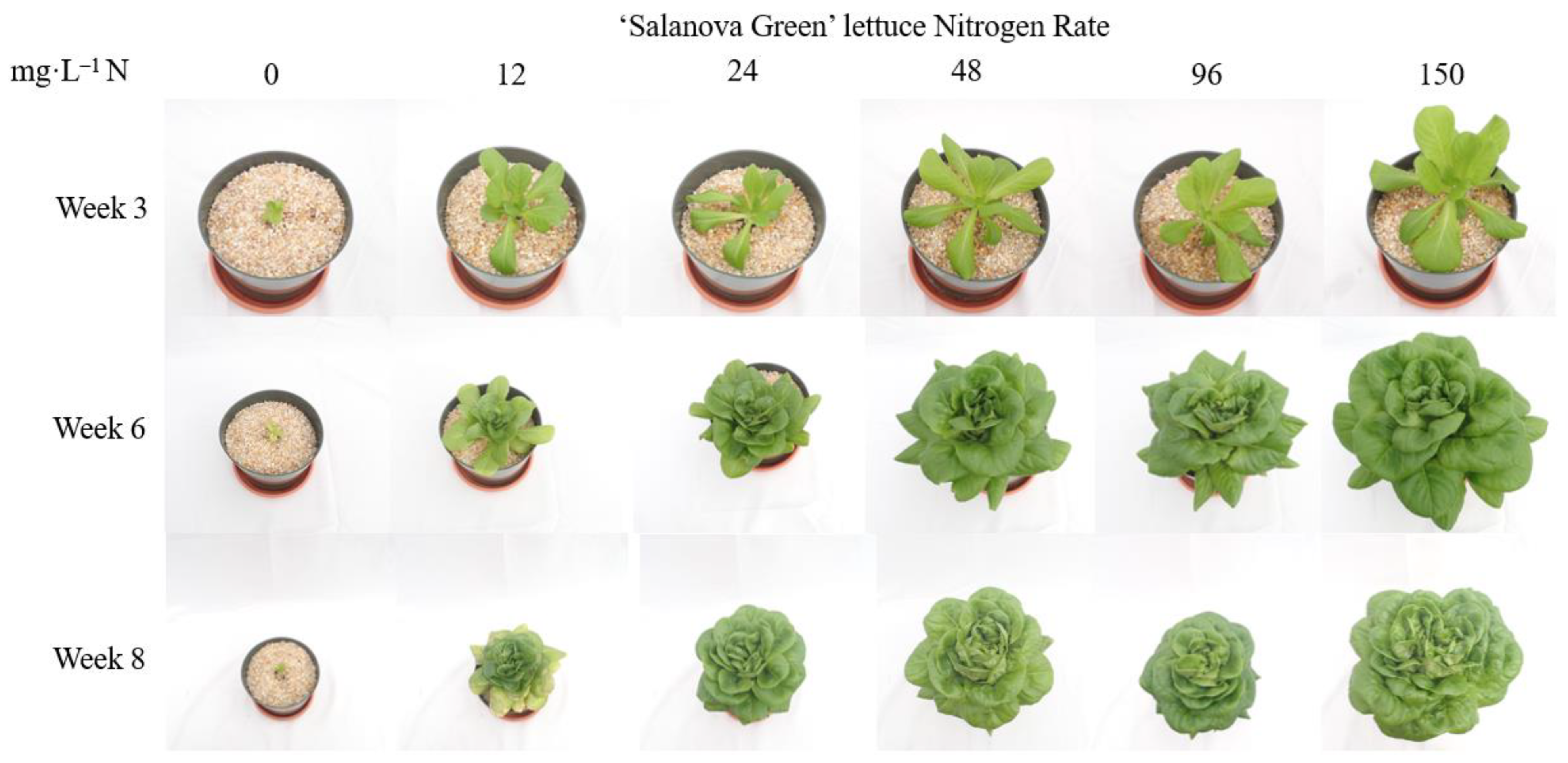
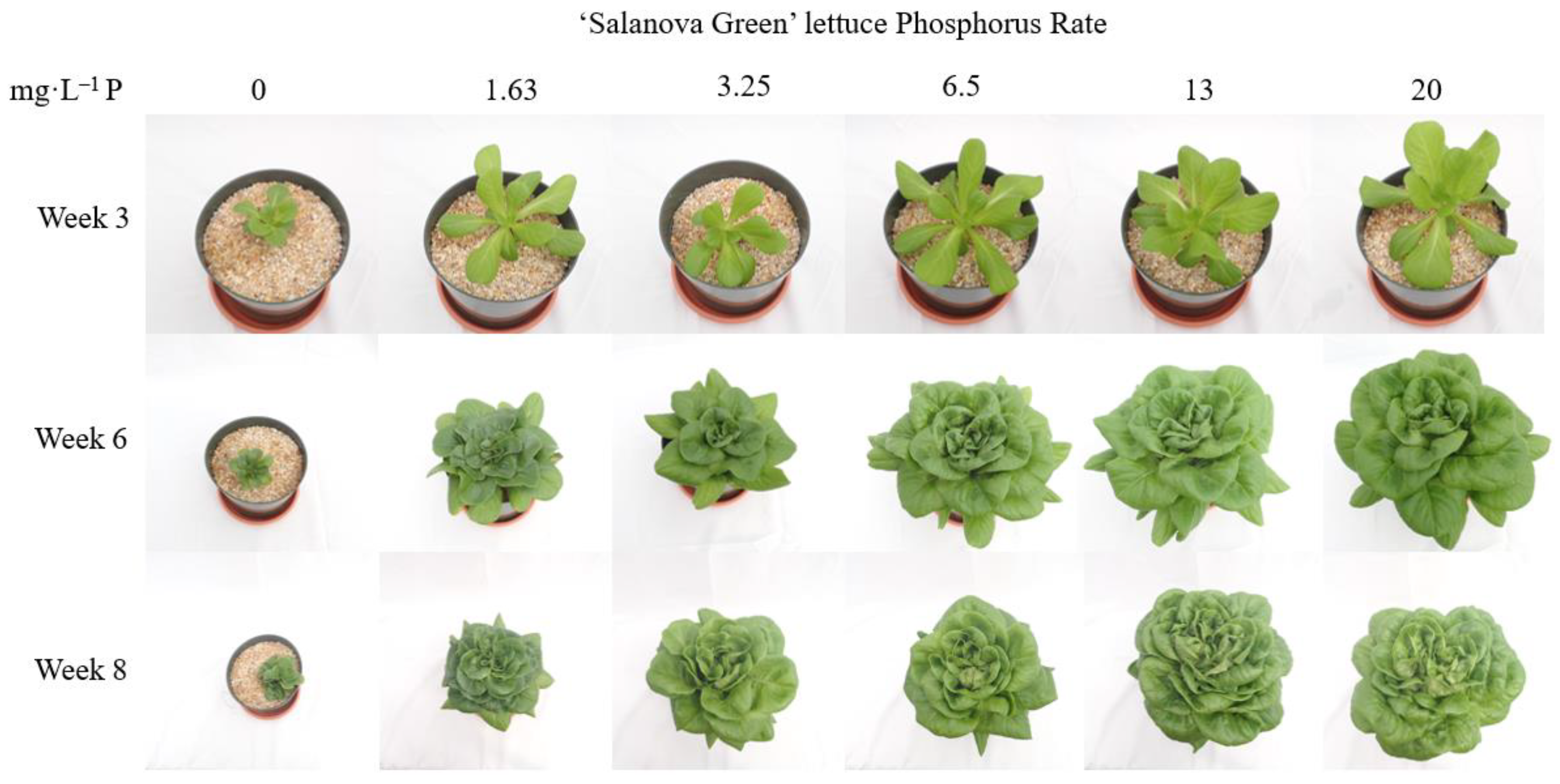
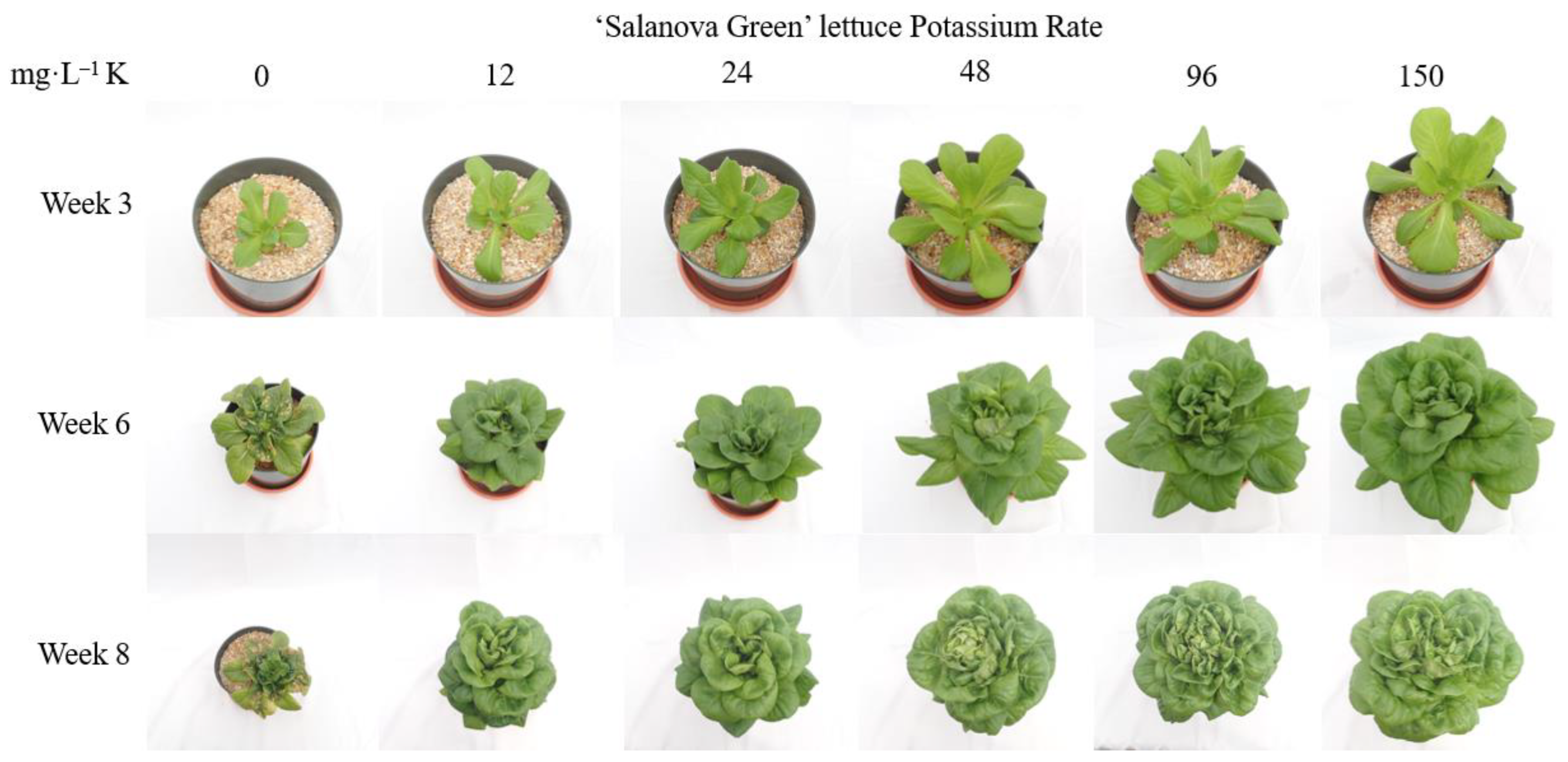
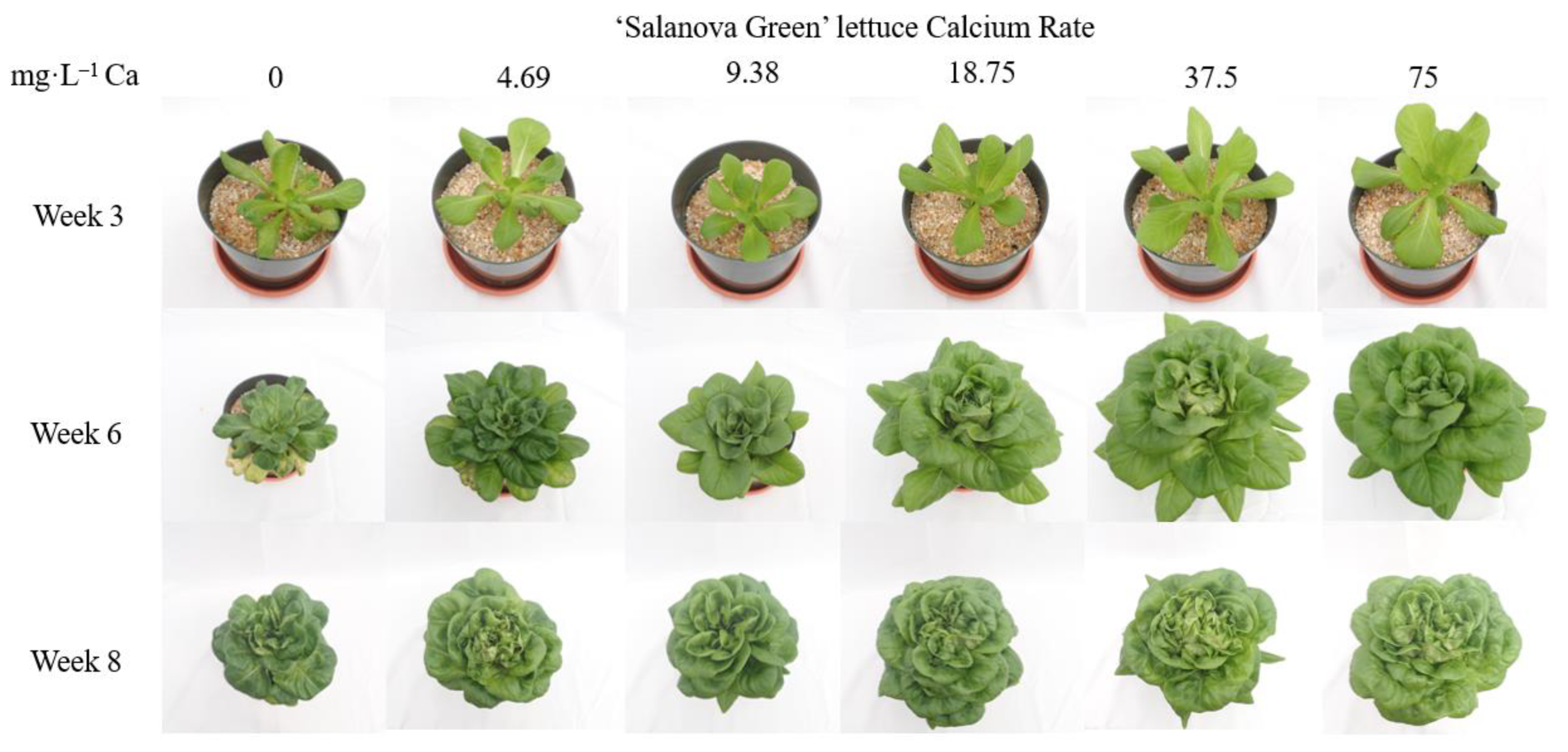
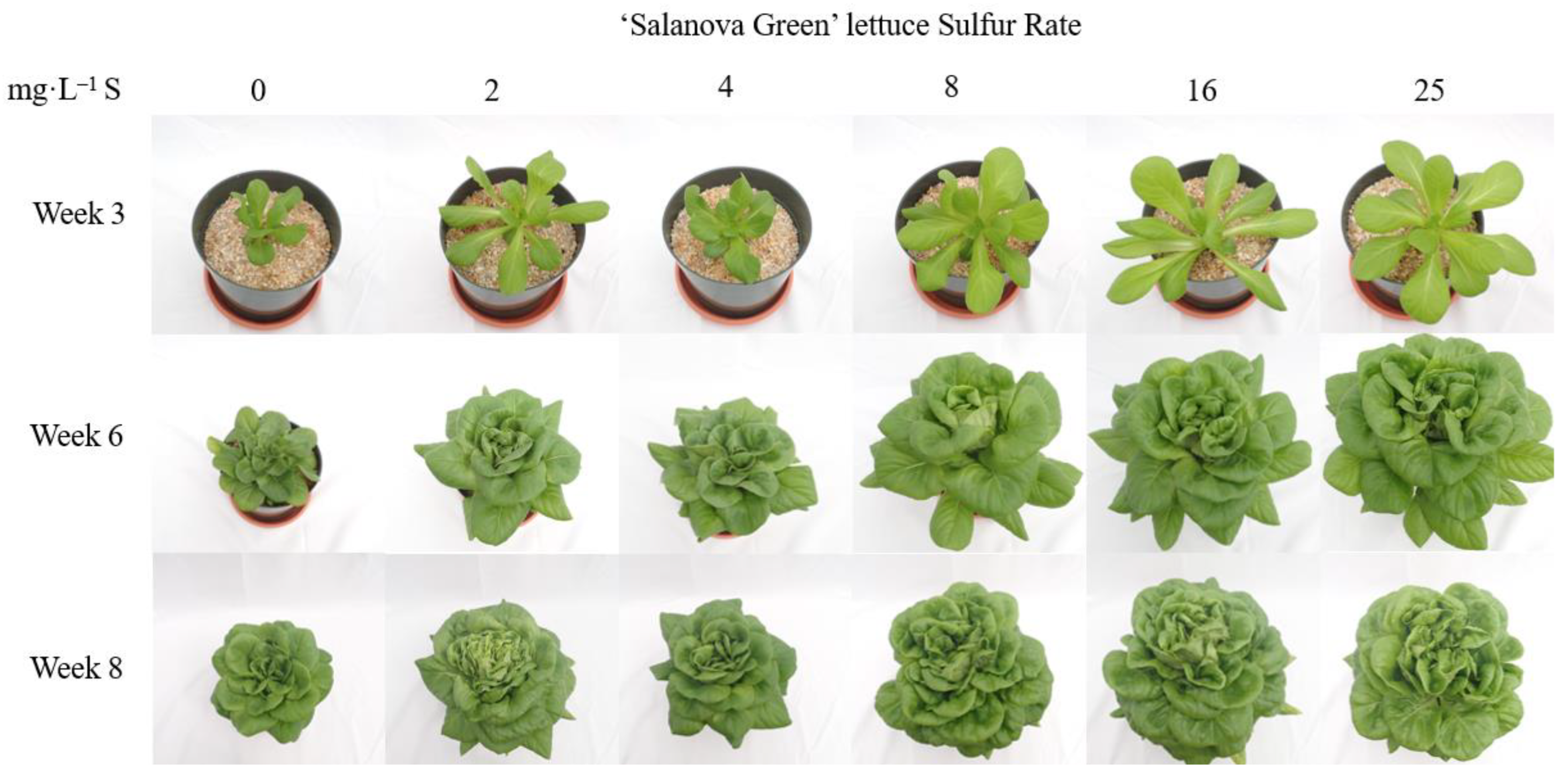
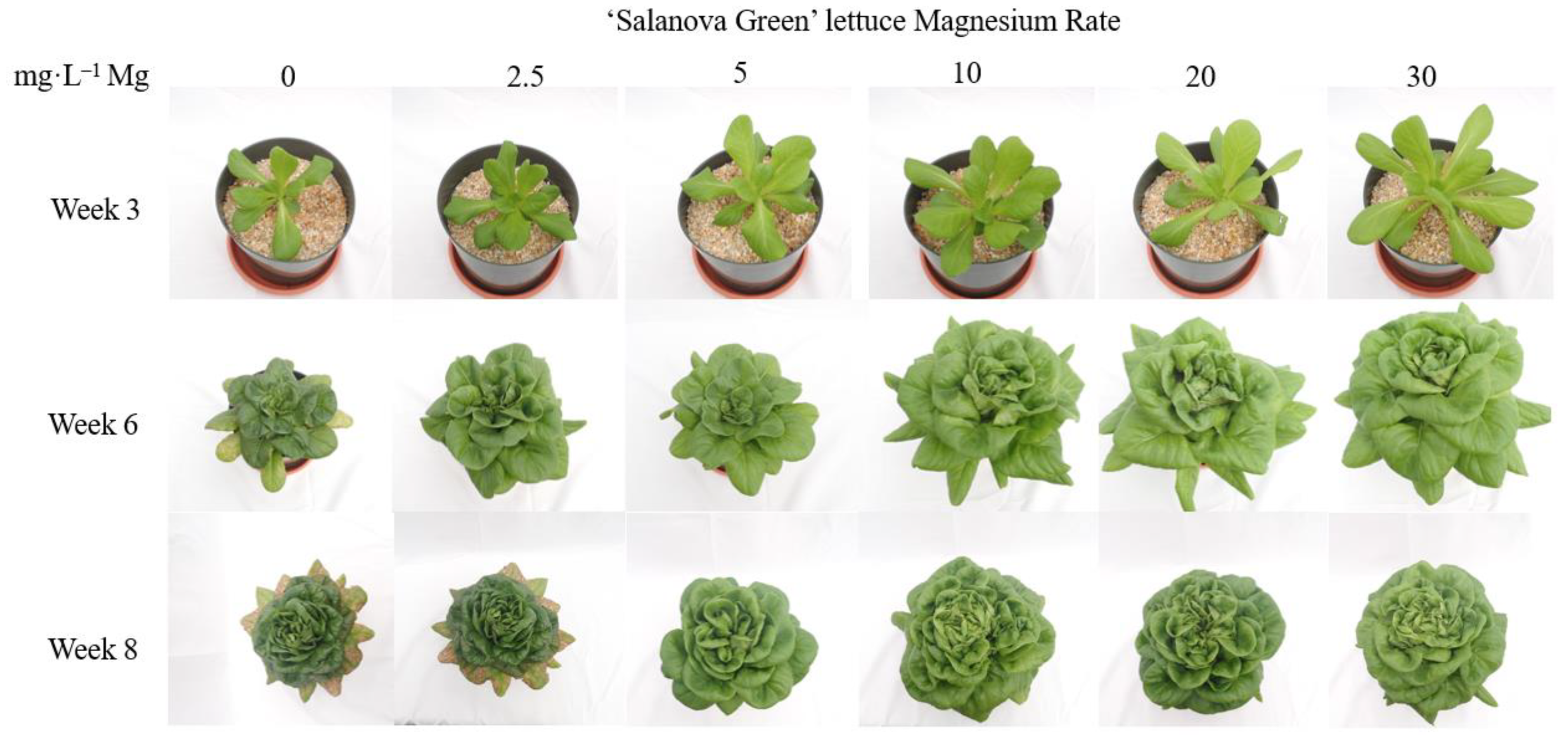
| Fertility Rate (%) 1 | 0.0 | 8.0 | 16.7 | 33.3 | 66.7 | 100.0 |
|---|---|---|---|---|---|---|
| mg·L−1 | mg·L−1 | mg·L−1 | mg·L−1 | mg·L−1 | mg·L−1 | |
| Nitrogen (N) | 0.0 | 12.0 | 24.0 | 48.0 | 96.0 | 150.0 |
| Phosphorus (P) | 0.0 | 1.63 | 3.25 | 6.50 | 13.0 | 20.0 |
| Potassium (K) | 0.0 | 12.0 | 24.0 | 48.0 | 96.0 | 150.0 |
| Calcium (Ca) | 0.0 | 4.7 | 9.8 | 18.75 | 37.5 | 75.0 |
| Sulfur (S) | 0.0 | 2.5 | 5.0 | 10.0 | 20.0 | 40.0 |
| Magnesium (Mg) | 0.0 | 2.0 | 4.0 | 8.0 | 16.0 | 25.0 |
| Micronutrient Fertility Rate (mg·L−1) 2 | ||||||
| All fertility rates | Fe 4.02 | Mn 0.99 | Cu 0.19 | Zn 0.20 | B 0.49 | Mo 0.01 |
| ‘Salanova Green’ | ||||||||
|---|---|---|---|---|---|---|---|---|
| Nitrogen Fertility Rate (mg·L−1) 1 | 0 | 12 | 24 | 48 | 96 | 150 | p-Value 2 | Equation of Best Fit |
| Plant Dry Weight (g) | ||||||||
| Week 3 | 0.02 C | 0.11 BC | 0.14 AB | 0.19 AB | 0.18 AB | 0.23 A | *** | (DW) = 0.024 + 0.007X − 0.0001X2; Xo = 52.78 |
| Week 6 | 0.02 C | 0.89 BC | 1.35 B | 3.35 A | 3.23 A | 4.03 A | *** | (DW) = 0.166 + 0.094X − 0.0006X2; Xo = 81.80 |
| Week 8 | 0.05 D | 2.20 C | 3.28 C | 6.58 B | 5.15 B | 9.33 A | *** | (DW) = 1.603 + 0.051X; R2 = 77.41 |
| Nitrogen Leaf Tissue Nutrient Concentrations (%) | ||||||||
| Week 3 | 1.11 C | 3.54 B | 3.96 AB | 3.94 AB | 4.77 A | 4.79 A | *** | (N) = 1.321 + 0.206X − 0.0034X2; Xo = 30.19 |
| Week 6 | 1.19 D | 1.63 D | 2.97 CD | 3.90 BC | 4.73 AB | 5.48 A | *** | (N) = 1.196 + 0.066X − 0.0003X2; Xo = 124.54 |
| Week 8 | 1.31 C | 1.81 C | 3.39 B | 3.76 B | 5.48 A | 5.35 A | *** | (N) = 1.263 + 0.074X − 0.0003X2; Xo = 111.40 |
| ‘Salanova Green’ | ||||||||
|---|---|---|---|---|---|---|---|---|
| Phosphorus Fertility Rate (mg·L−1) 1 | 0 | 1.63 | 3.25 | 6.5 | 13 | 20 | p-Value 2 | Equation of Best Fit |
| Plant Dry Weight (g) | ||||||||
| Week 3 | 0.08 A | 0.16 A | 0.25 A | 0.16A | 0.16 A | 0.23 A | NS | NS |
| Week 6 | 0.45 C | 1.99 B | 1.55 BC | 3.58 A | 3.50 A | 4.03 A | *** | (DW) = 0.555 + 0.559X − 0.028X2; Xo = 10.81 |
| Week 8 | 0.43 B | 2.77 B | 2.93 B | 6.88 A | 9.28 A | 9.33 A | *** | (DW) = 0.408 + 1.187X − 0.039X2; Xo = 15.15 |
| Phosphorus Leaf Tissue Nutrient Concentrations (%) | ||||||||
| Week 3 | 0.34 C | 0.54 BC | 0.74 AB | 0.87 A | 0.86 A | 0.71 A | ** | (P) = 0.321 + 0.178X − 0.016X2; Xo = 5.47 |
| Week 6 | 0.09 C | 0.17 C | 0.43 B | 0.43 B | 0.66 A | 0.70 A | *** | (P) = 0.094 + 0.789X − 0.003X2; Xo = 14.76 |
| Week 8 | 0.12 C | 0.14 C | 0.44 B | 0.55 AB | 0.73 A | 0.49 B | *** | (P) = 0.073 + 0.1092X − 0.006X2; Xo = 9.86 |
| ‘Salanova Green’ | ||||||||
|---|---|---|---|---|---|---|---|---|
| Potassium Fertility Rate (mg·L−1) 1 | 0 | 12 | 24 | 48 | 96 | 150 | p-Value 2 | Equation of Best Fit |
| Plant Dry Weight (g) | ||||||||
| Week 3 | 0.11 B | 0.13 AB | 0.14 AB | 0.21 A | 0.18 AB | 0.23 A | *** | (DW) = 0.098 + 0.003X − 0.00002X2; Xo = 74.67 |
| Week 6 | 1.10 C | 2.30 BC | 2.45 ABC | 3.85 AB | 3.80 AB | 4.03 A | *** | (DW) = 1.157 + 0.081X − 0.00062; Xo = 68.57 |
| Week 8 | 0.97 D | 5.40 BC | 4.75 C | 7.25 AB | 7.28 AB | 9.33 A | *** | (DW) = 1.516 + 0.233X − 0.00232; Xo = 50.07 |
| Potassium Leaf Tissue Nutrient Concentrations (%) | ||||||||
| Week 3 | 1.41 C | 3.02 B | 3.87 B | 6.45 A | 6.81 A | 7.21 A | *** | (K) = 1.333 + 0.144X − 0.0009X2; Xo = 79.46 |
| Week 6 | 0.39 D | 1.03 D | 4.88 BC | 4.24 C | 7.11 AB | 8.28 A | *** | (K) = 0.669 + 0.106X − 0.00037X2; Xo = 141.33 |
| Week 8 | 0.47 B | 0.98 B | 2.74 B | 2.66 B | 5.49 A | 7.07 A | *** | (K) = 0.553 + 0.061X − 0.0001X2 |
| ‘Salanova Green’ | ||||||||
|---|---|---|---|---|---|---|---|---|
| Calcium Fertility Rate (mg·L−1) 1 | 0.0 | 4.69 | 9.38 | 18.75 | 37.50 | 75.0 | p-Value 2 | Equation of Best Fit |
| Plant Dry Weight (g) | ||||||||
| Week 3 | 0.14 B | 0.14 B | 0.12 B | 0.13 B | 0.21 A | 0.23 A | *** | (DW) = 0.117 + 0.003X − 0.00002X2; Xo = 68.91 |
| Week 6 | 1.65 D | 2.15 BCD | 1.98 CD | 4.30 AB | 4.70 A | 4.03 ABC | *** | (DW) = 1.3823 + 0.168X − 0.00233X2; Xo = 36.11 |
| Week 8 | 3.58 C | 5.68 B | 5.73 B | 9.25 A | 9.43 A | 9.33 A | *** | (DW) = 3.5274 + 0.397X − 0.00663X2; Xo = 29.90 |
| Calcium Leaf Tissue Nutrient Concentrations (%) | ||||||||
| Week 3 | 0.34 B | 0.38 B | 0.96 A | 1.07 A | 1.07 A | 1.17 A | *** | (Ca) = 1.840 + 0.073X − 0.00156X2; Xo = 23.34 |
| Week 6 | 0.20 C | 0.26 C | 0.61 BC | 0.85 AB | 1.04 AB | 1.24 A | *** | (Ca) = 0.186 + 0.040X − 0.00040X2; Xo = 50.28 |
| Week 8 | 0.26 C | 0.26 C | 0.58 BC | 0.67 BC | 0.86 B | 1.33 A | *** | (Ca) = 0.267 + 0.021X − 0.00009X2 |
| ‘Salanova Green’ | ||||||||
|---|---|---|---|---|---|---|---|---|
| Sulfur Fertility Rate (mg·L−1) 1 | 0.0 | 2.0 | 4.0 | 8.0 | 16.0 | 25.0 | p-Value 2 | Equation of Best Fit |
| Plant Dry Weight (g) | ||||||||
| Week 3 | 0.11 B | 0.16 AB | 0.17 AB | 0.19 AB | 0.25 AB | 0.30 A | * | (DW) = 0.120 + 0.013X − 0.00031X2; Xo = 20.29 |
| Week 6 | 1.65 C | 3.60 AB | 2.73 BC | 4.35 A | 4.43 A | 4.55 A | *** | (DW) = 1.964 + 0.427X − 0.0180X2; Xo = 11.84 |
| Week 8 | 4.40 C | 8.75 AB | 5.60 BC | 8.18 AB | 10.23 A | 9.70 A | *** | (DW) = 5.397 + 0.469X − 0.0121X2; Xo = 19.32 |
| Sulfur Leaf Tissue Nutrient Concentrations (%) | ||||||||
| Week 3 | 0.19 B | 0.25 A | 0.26 A | 0.28 A | 0.29 A | 0.28 A | *** | NS |
| Week 6 | 0.19 B | 0.25 A | 0.25 A | 0.28 A | 0.28 A | 0.29 A | *** | (S) = 0.197 + 0.025X − 0.0018X2; Xo = 6.99 |
| Week 8 | 0.15 B | 0.26 A | 0.27 A | 0.28A | 0.29 A | 0.28 A | *** | (S) = 0.153 + 0.075X − 0.0114X2; Xo = 3.30 |
| ‘Salanova Green’ | ||||||||
|---|---|---|---|---|---|---|---|---|
| Magnesium Fertility Rate (mg·L−1) 1 | 0.0 | 2.5 | 5.0 | 10.0 | 20.0 | 30.0 | p-Value 2 | Equation of Best Fit |
| Plant Dry Weight (g) | ||||||||
| Week 3 | 0.14 A | 0.12 A | 0.17 A | 0.16 A | 0.19 A | 0.18 A | NS | NS |
| Week 6 | 1.18 C | 2.65 BC | 2.20 BC | 3.90 AB | 4.53 A | 4.83 A | *** | (DW) = 1.369 + 0.303X − 0.0069X2; Xo = 22.08 |
| Week 8 | 2.27 D | 5.90 BC | 5.20 C | 9.10 A | 7.88 AB | 8.30 A | *** | (DW) = 2.584 + 0.979X − 0.0417X2; Xo = 11.73 |
| Magnesium Leaf Tissue Nutrient Concentrations (%) | ||||||||
| Week 3 | 0.26 D | 0.30 D | 0.38 C | 0.46 B | 0.43 BC | 0.56 A | *** | (Mg) = 0.278 + 0.015X − 0.0022X2 |
| Week 6 | 0.10 D | 0.15 CD | 0.19 C | 0.35 B | 0.40 AB | 0.45 A | *** | (Mg) = 0.089 + 0.027X − 0.0005X2; Xo = 25.85 |
| Week 8 | 0.10 D | 0.19 CD | 0.29 C | 0.46 B | 0.55 B | 0.71 A | *** | (Mg) = 0.112 + 0.035X − 0.0005X2 |
Publisher’s Note: MDPI stays neutral with regard to jurisdictional claims in published maps and institutional affiliations. |
© 2022 by the authors. Licensee MDPI, Basel, Switzerland. This article is an open access article distributed under the terms and conditions of the Creative Commons Attribution (CC BY) license (https://creativecommons.org/licenses/by/4.0/).
Share and Cite
Veazie, P.; Pandey, P.; Young, S.; Ballance, M.S.; Hicks, K.; Whipker, B. Impact of Macronutrient Fertility on Mineral Uptake and Growth of Lactuca sativa ‘Salanova Green’ in a Hydroponic System. Horticulturae 2022, 8, 1075. https://doi.org/10.3390/horticulturae8111075
Veazie P, Pandey P, Young S, Ballance MS, Hicks K, Whipker B. Impact of Macronutrient Fertility on Mineral Uptake and Growth of Lactuca sativa ‘Salanova Green’ in a Hydroponic System. Horticulturae. 2022; 8(11):1075. https://doi.org/10.3390/horticulturae8111075
Chicago/Turabian StyleVeazie, Patrick, Piyush Pandey, Sierra Young, M. Seth Ballance, Kristin Hicks, and Brian Whipker. 2022. "Impact of Macronutrient Fertility on Mineral Uptake and Growth of Lactuca sativa ‘Salanova Green’ in a Hydroponic System" Horticulturae 8, no. 11: 1075. https://doi.org/10.3390/horticulturae8111075
APA StyleVeazie, P., Pandey, P., Young, S., Ballance, M. S., Hicks, K., & Whipker, B. (2022). Impact of Macronutrient Fertility on Mineral Uptake and Growth of Lactuca sativa ‘Salanova Green’ in a Hydroponic System. Horticulturae, 8(11), 1075. https://doi.org/10.3390/horticulturae8111075






